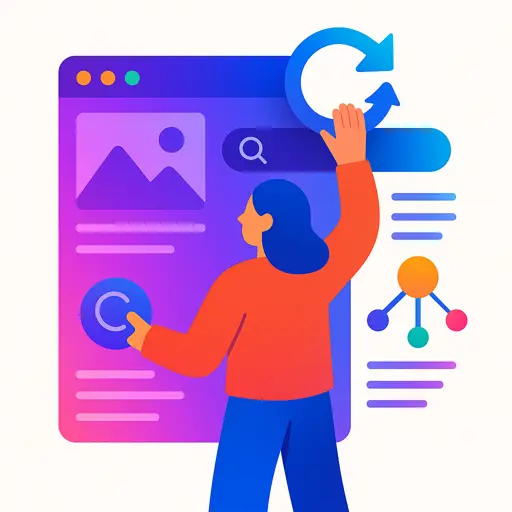
Content Refresh Guide: How to Improve Your Search & AI Visibility
Published October 20, 2025
Thank you to Sean Begg Flint who walks us through how to effectively refresh your content to protect (and improve) traffic.
Even your best-performing content has an expiry date. Facts become outdated. Best practices evolve. Search intent shifts. Over time, newer pages with fresher data and more relevant insights will start to outrank yours.
And you’re not just competing with other publishers. AI Overviews and large language models (LLMs) are actively stealing your traffic, too. Users can get instant, personalized answers without ever needing to visit your website.
But it isn’t all doom and gloom. You can still reclaim those lost visits with a smart, strategic content refresh.
As the founder of Position Digital, I’ve done this a thousand times for my clients. I’ve seen what works (and what flops). I also spoke to a few seasoned SEOs to get their take on what’s working for them right now.
In this guide, I’ll share everything we’ve learned.
Contents:
But first, do content refreshes actually work?
You might be wondering, “Does refreshing my existing content actually move the needle?” or “What if I update a post and my traffic drops instead of climbing?”
Those are valid concerns. After all, no one wants to waste time and energy on something that offers no return.
But here’s the thing: when done strategically, content refreshes do work. In fact, it’s one of the most effective ways to increase traffic and visibility in a world where AI-driven search reigns supreme.
We’ve seen refreshed posts double their traffic. Rank for entirely new keywords. And yes, become more visible in AI Overviews.
Take Oriel Partners, for example, one of our clients at Position Digital.
After we updated one of their articles, the number of keywords ranking number 1 jumped from 0 to 23. It was also featured in AI Overviews for 17 keywords, which led to a 131% increase in traffic.
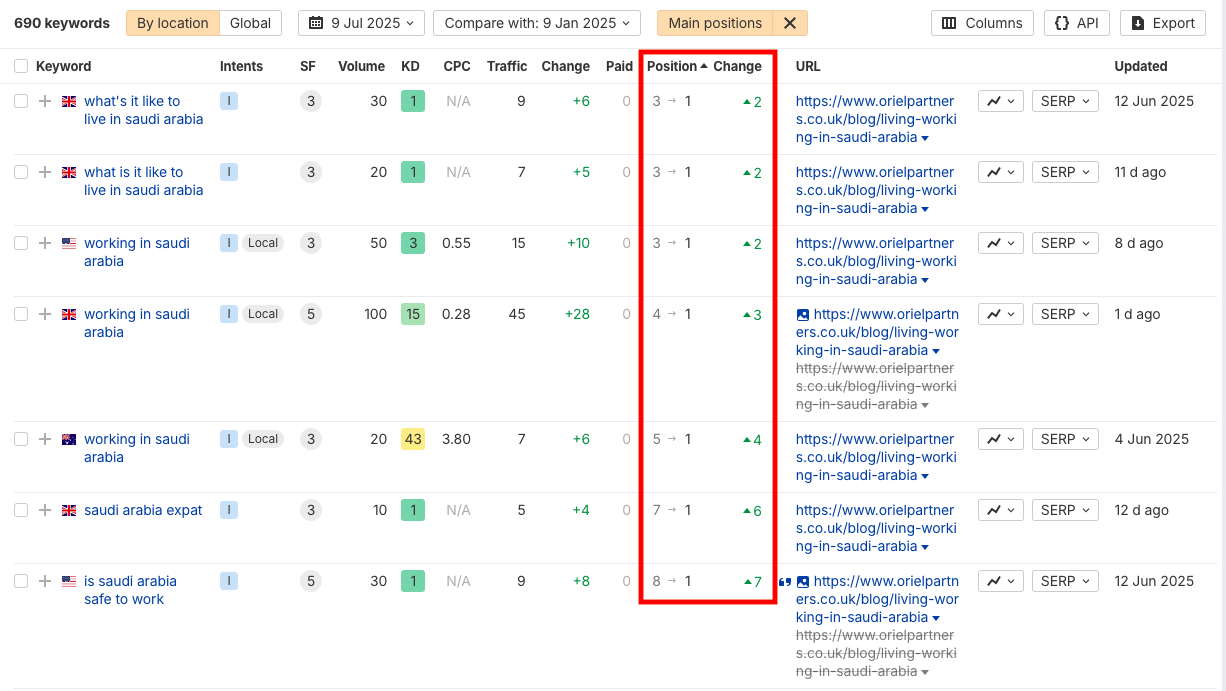
Image Source: Position Digital
So, how did we do it? Here’s our step-by-step process.
Step 1: Gather all your content
Before you can refresh your content, you need a complete picture of everything you’ve published on your website. This includes blog posts, landing pages, and other core web pages.
Start by using a crawling tool like Sitebulb to scan your entire site. Once you get the full list of every live page, collect these details:
URL
Page title (H1)
Meta title
Meta description
Content format
Word count
Last modified date
Next, export the data to an Excel spreadsheet or Google Sheet. Here’s a content audit template you can customize to your exact needs.

Step 2: Perform a content audit
Now that you’ve got your full content inventory, it’s time to audit the content. This begins with evaluating how each page is performing. This will help you prioritize which content pieces to refresh based on their current value and potential.
Check SERP performance
Use Google Search Console to see how well (or poor) your pages perform on search engine results pages (SERPs).
Key metrics to review:
Impressions: The number of times your content appears in search results.
Clicks: The number of times users actually click on your page after seeing it in search results.
Click-through rate (CTR): The ratio of clicks to impressions.
Average position: The average ranking of your page for its target keywords.
Check engagement metrics
You can also analyze engagement metrics using Google Analytics.
Take a look at:
Page views: The number of times your page is visited.
Bounce rate: The percentage of users leaving your page immediately without visiting other pages.
Time on page: How long visitors stay on your page.
Conversion rate: The percentage of users who have completed a desired action, such as submitting a form or making a purchase.
Identify pages with technical issues
Apart from performance metrics, it's also crucial to look for pages with technical issues, as they could affect indexability and user experience.
Sitebulb has Prioritized Hints, which automatically show you errors on your site. Instead of spending hours doing manual audits, these hints can help you quickly identify problems like:
Broken links
Duplicate content
Missing or unoptimized meta tags
Slow-loading time
Thin content or low word count
Sitebulb also provides context and actionable recommendations for each issue, making it easier to understand what needs fixing and why it matters.

Don’t forget to add these performance metrics and technical issue reports to the spreadsheet you’ve created before.
Step 3: Identify content to refresh
If you have a small website with just a handful of content, updating everything might be manageable. But what if your site has hundreds or even thousands of pages? It might take forever to complete!
That’s why you need to be smart with your content refresh strategy. Focus your time and energy on content pieces that will actually benefit from an update.
In general, we usually prioritize these types of content:
Time-sensitive content
According to Google, content freshness carries more weight in time-sensitive pages compared to informational, Wikipedia-style blog posts.

Image source: Google
Some examples of time-sensitive content:
News articles
Blog posts with a year reference (e.g., best email tools for 2025)
Event pages
Statistical reports
Seasonal content (e.g., holiday guides)
Product-led content
As your products evolve, new features are added, while old ones are updated or even deprecated. So, your content needs to reflect these changes accurately to avoid misleading customers or missing opportunities to highlight improvements.
Make sure to keep these pages up-to-date:
Product and pricing pages
Tutorials and how-to guides
Case studies and success stories
Comparison articles (e.g., "Asana vs. Trello")
FAQs related to products
To save time, you can use Sitebulb’s content extraction to quickly pull all pages containing specific product names.
This feature comes in handy when you’ve just released a new feature and want to update all relevant content across your site – like tutorials, pricing references, or FAQs – without having to manually comb through every page.
Low-hanging fruit content
Instead of updating everything at once, keep your focus on pages that offer quick SEO wins:
High-performing posts on a decline: Find content that used to perform well but has recently dropped in rankings or organic traffic. These pages already have SEO authority – they may just need updated stats, improved formatting, or better internal linking to bounce back.
Posts that rank between 11-20: Identify posts ranking on page 2 of Google that could reach page 1 with minor updates and optimizations. It’s easier to move something from position 15 to 1, than it is to rank a new article from 100 to 15.
High impressions, low clicks: Look for pages that show up in search results but aren’t getting clicks. This is often a sign that your title or meta description needs some work, or AI Overviews are taking away your clicks.
The easiest way to find low-hanging fruit pages is through Google Search Console (GSC).

“I would focus on identifying “quick win keywords” using Google Search Console. I search for the specific page I am looking to optimize and then sort keywords by impressions. Any keywords that have high impressions but low clicks are your "quick wins". They show relevant keywords that are gaining traction but are not currently optimized for. By optimizing for those keywords, you can boost visibility and engagement.”
Here’s how to do that:
Open your GSC dashboard and go to Performance.
Set a custom date range (e.g. last 3 months) and compare it with the previous period.
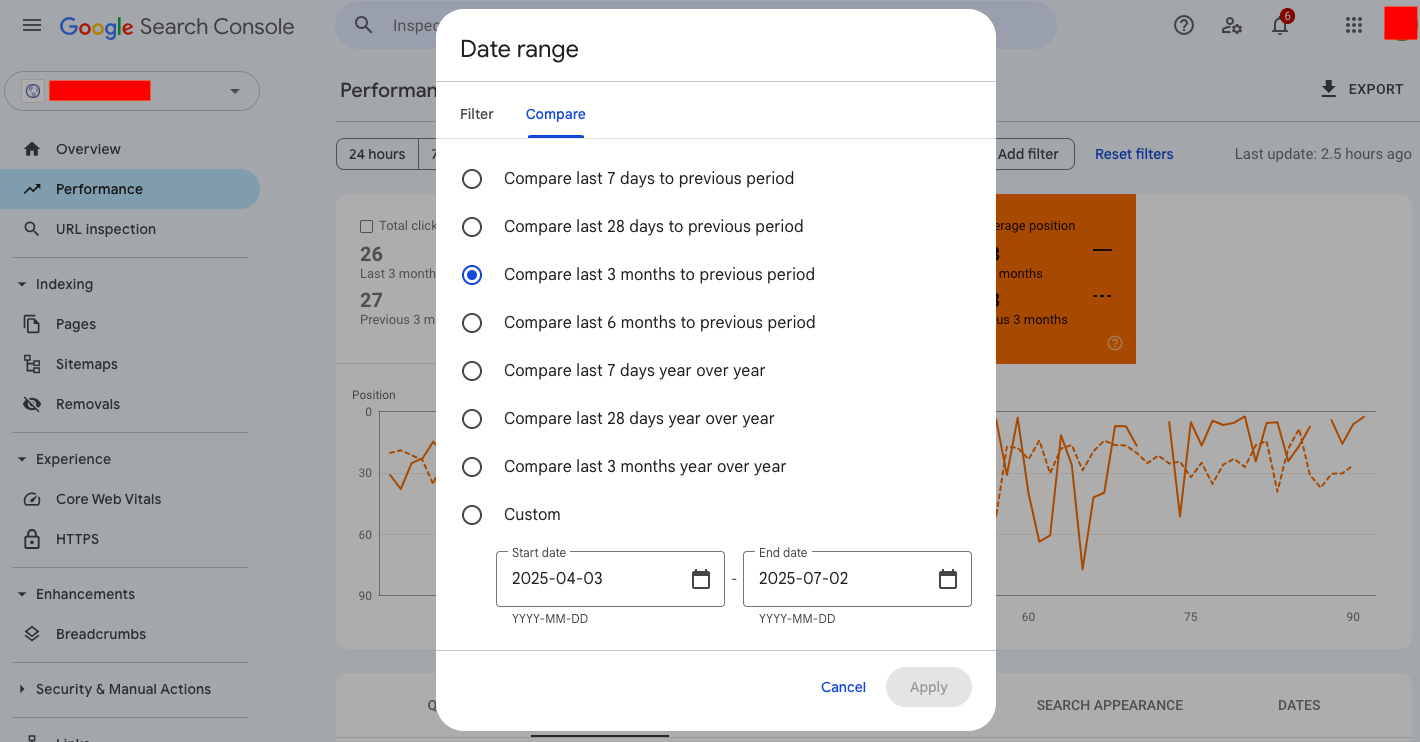
Scroll to the Pages tab and sort by Clicks or Impressions. Look for URLs where those numbers have dipped.
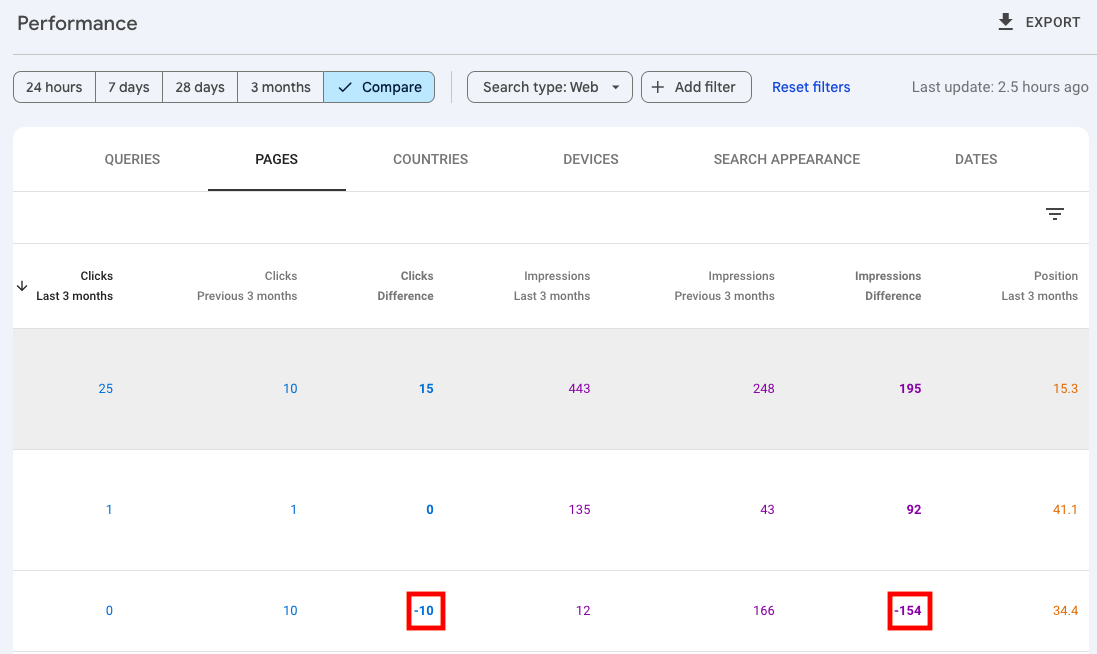
Filter by Average CTR to find pages with low click-through rates.
Use the Average Position filter to spot posts ranking in positions 11–20.
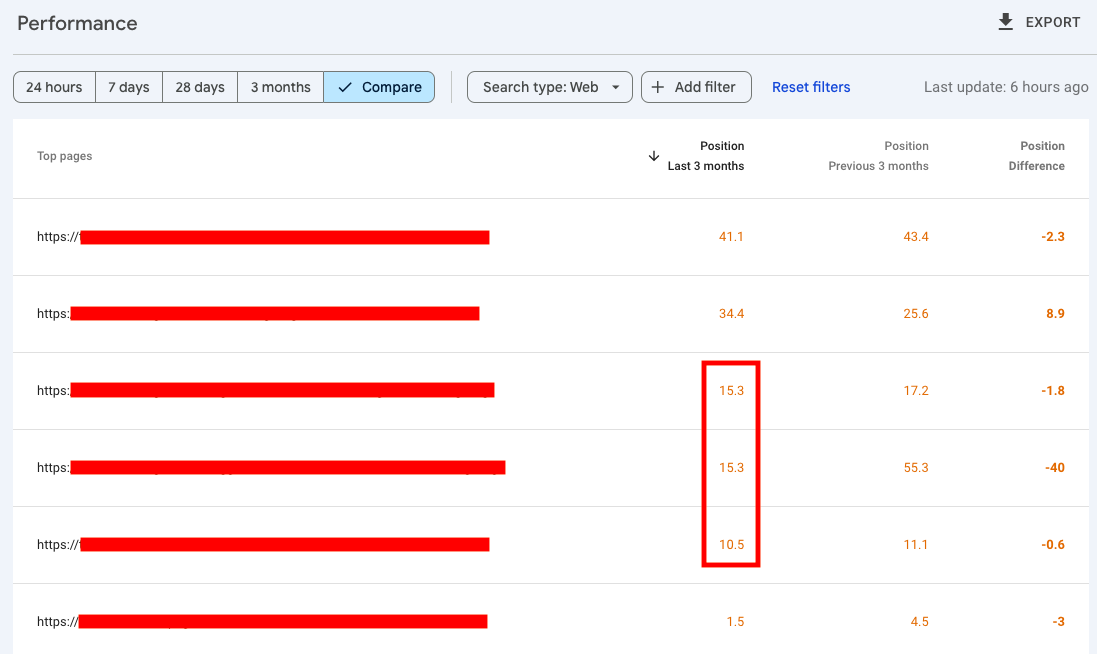
About page and FAQ sections
For a long time, about pages were treated like an afterthought. A box to tick. A nice-to-have page that was mostly ignored by both readers and search engines.
But in the age of AI Overviews and LLMs, it plays a much more central role. According to an Ahrefs study, core website pages (including about pages) are content types that get the most citations in LLM answers.
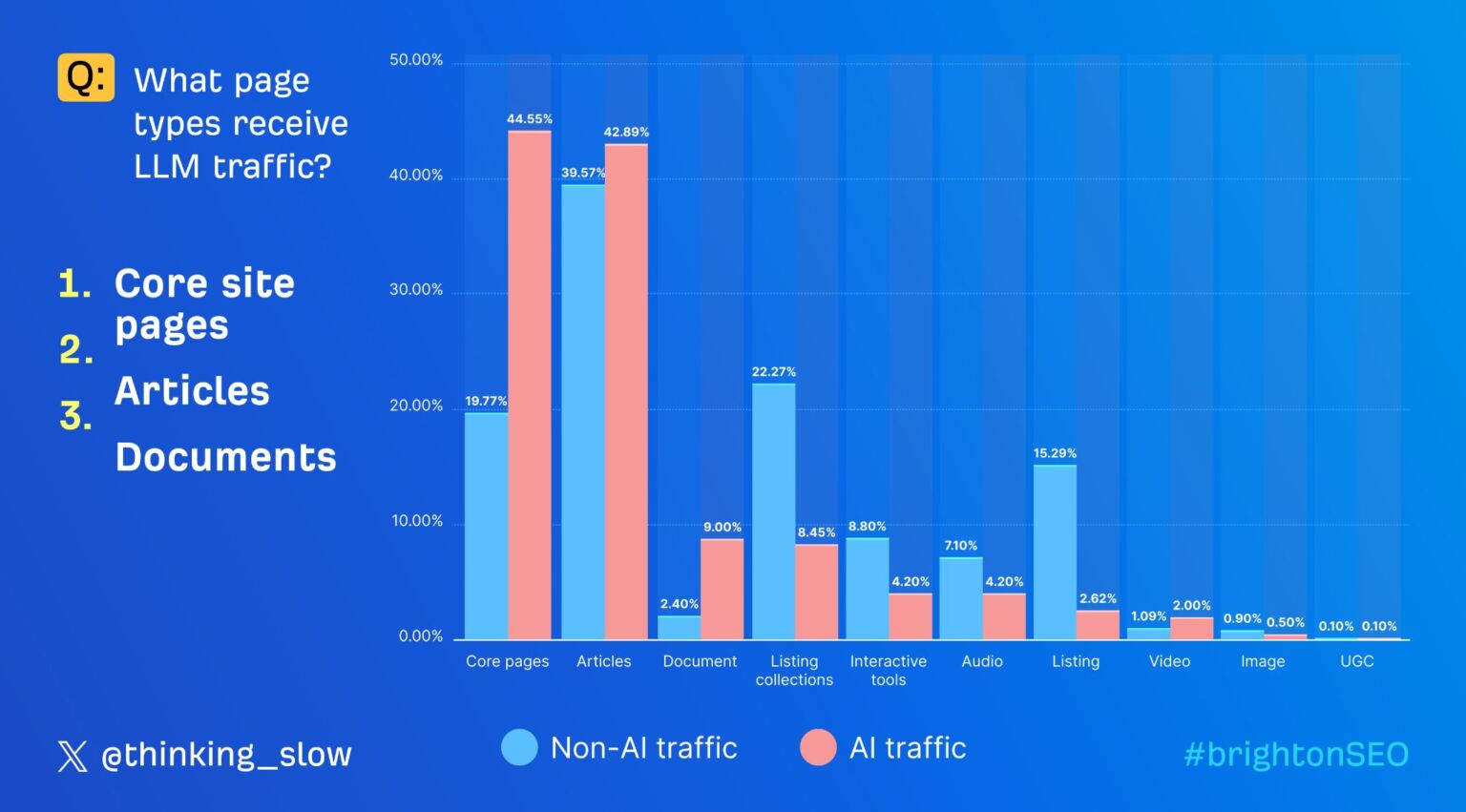
Image source: Ahrefs
Why? Because AI models look for signals of expertise, authority, and credibility when finding sources. A well-written about page helps AI understand who you are, why you're credible, and what experience or authority you bring to the topic.
More importantly, it gives AI bots structured context about your company, products, and services. If you don’t give AI that context, it might try to fill in the blanks itself. That’s when AI starts hallucinating and making things up about your brand.
The same goes for FAQ sections. What used to be a functional add-on at the bottom of a page is now a goldmine for AI visibility. FAQs help AI models identify direct, conversational answers to common questions.
Think of your FAQ section as your chance to answer the questions your audience is already asking.
Step 4: Develop an action plan
Based on your audit and performance analysis, it’s time to decide what to do with each piece of content. Not every post needs a full rewrite – some may only require a minor update, while others are better off removed or merged.
Use a simple tagging system in your spreadsheet to assign one of the following actions to each URL:
Leave as is: If the content is still fresh and performing as expected, you can leave it alone.
Update: These are time-sensitive or product-led content pieces that are still performing great, but need minor updates to keep the facts accurate.
Rewrite: These pages target a valuable topic but are outdated, shallow, or poorly structured. A full content overhaul can help them better align with user intent and current SEO best practices.
Merge: You may find multiple posts covering the same or very similar topics. Consolidating them into a single page is your best option to avoid cannibalization and improve performance. If you’re unsure which pages to merge or delete, this duplicate content guide breaks it all down.
Remove: For outdated content that targets irrelevant topics, has zero traffic and zero SEO value, I’d suggest removing it completely. If the content has some nice backlinks, however, consider setting up a 301 redirect to another relevant page.
Here’s a content audit action plan template you can copy and tailor to your liking.

Step 5: Perform on-page content updates
You’ve got a clear idea of which pieces need an update. Now it’s time to roll up your sleeves and start updating your content.
Follow our content refresh checklist:
Update old information
No one wants to read a study or advice from 2020 in 2025. If you want to maintain authority and relevance, regularly revisit and update any information that’s no longer accurate or current:
Replace old statistics with current facts from credible sources.
Update screenshots and images to reflect the latest versions of a website, app, or product.
Make sure all internal and external links still work and lead to the correct pages. If you find any broken links, fix them immediately.
At the end of each year, we set a reminder to update all of our clients’ content pieces that reference a particular year. We update it with new stats and research to keep it at the top of the SERPs.
Here’s an example of a piece we refreshed for our client HR Datahub. After we updated it with fresh stats to align with 2025, the article jumped to position 3 and is now cited in AI Overviews, Perplexity, and ChatGPT.
You can read the HR Datahub case study here.
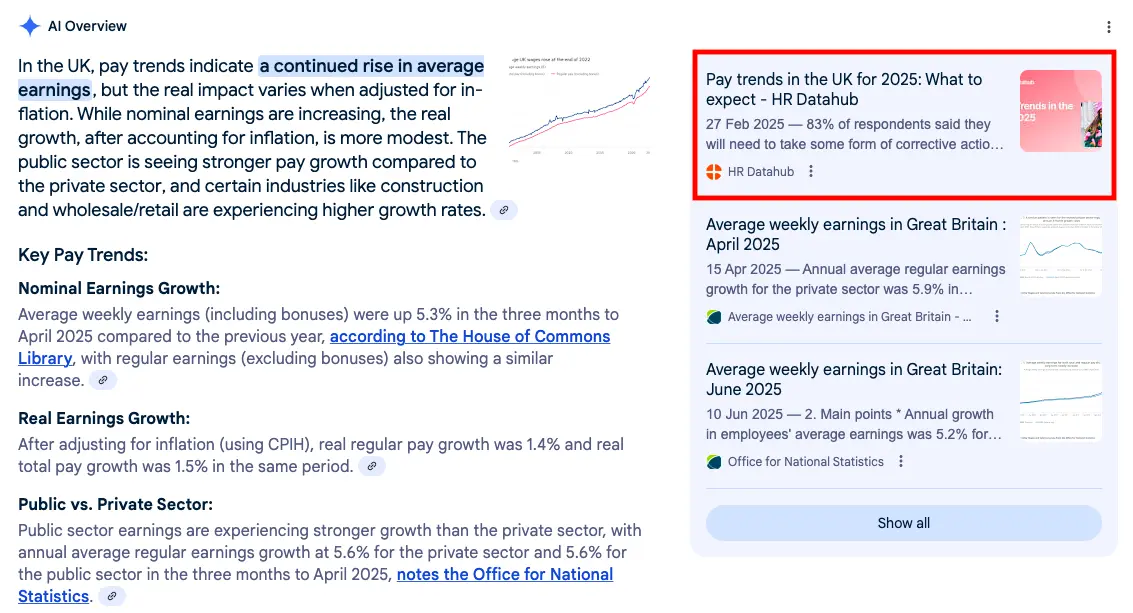
Image source: Position Digital
Optimize for search intent
Make sure your content still aligns with what users are actively searching for. Start by reviewing the primary keyword, and analyze the top-ranking pages to check whether search intent has shifted.
You should also optimize your content to reflect your brand’s current voice and positioning. As your audience evolves, so do the questions they ask and the language they use.

“When I’m optimizing content, I always make it a cross-functional effort. I’ll sync with Product Marketing, PR, Community, CSMs, and/or Sales to make sure our positioning is still accurate and our messaging still resonates. Does it answer the questions our audience is asking right now? At the end of the day, SEO content has to be genuinely helpful and informative.”
Analyze competitors to find content gaps
If you want to rank high for a given keyword, it’s not enough to simply match what’s already on the first page – you need to do better.
Here’s how to identify opportunities:
Know your competitors: Google your keyword and list the top-ranking pages.
Analyze their content: How is it structured? How deeply do they cover the topic?
Spot content gaps: What subtopics, angles, or keywords haven’t you covered?

“I like using Surfer SEO to refresh content because it highlights opportunities within content that could be better optimized based on who is already ranking. It's helpful when content isn't performing as well as it used to, and you know that competitors have been creating new content that eclipses your existing content.”
Want to go deeper? Check out my comprehensive guide on competitor analysis, covering tips and tool recommendations from 20 senior SEOs.
Add more depth to your content
Once you know what your content is missing, you can start adding those key points to make your content more valuable:
Add missing sections: Cover the topic more thoroughly by including relevant subtopics and sections.
Target new keywords: Naturally integrate related keywords your competitors are getting traffic from.
Include relevant FAQs: Add a FAQ section to answer common user questions, especially those found in the “People Also Ask” box or Google Autosuggest.
Implement E-E-A-T: Show your authority by adding your personal experience and experiments, or incorporate unique insights from experts.
Improve UX and readability
Readers don’t always read everything – they scan for the info they need. Your job is to make it easy for them to skim and navigate your content.

“I simplify headers so that they're understandable to someone scanning the page, and I like formatting a stand-out point as a quote box so it teases something that's otherwise buried lower on the page.””
Here’s what you need to do:
Break up long paragraphs: Walls of text can overwhelm readers. Keep paragraphs short (2–4 lines max) for easier scanning.
Use clear headers: Your H2s and H3s should clearly communicate what’s in each section. Avoid vague or clever headings that don’t reflect the content.
Add bullet points and numbered lists: Lists help structure complex information, highlight key takeaways, and make your content easier to digest.
Use visual hierarchy: Use bold, italics, and block quotes to emphasize important information. You can also add images or screenshots to break up the text.
Insert whitespace strategically: Give your content breathing room – especially between sections or around CTAs.
Step 6: Optimize your content for AI and LLMs
Generative AI tools don’t “rank” content in the same way traditional search engines do. Instead, they combine information from various sources and summarize it for users.
Now the million-dollar question is, how do you rank in Google’s AI Mode and AI Overviews, as well as popular LLMs like ChatGPT?
While there’s no definitive answer (yet), early research and SEO experiments give us several clues:
Update your brand positioning across your site
AI engines and LLMs generate responses based on patterns in their training data and across the web. That means if they consistently see your brand name associated with specific phrases, those associations become part of your brand identity.
For example, if your homepage, blog, and press coverage consistently refer to you as “the go-to CRM software for Australian plumbing companies”, AI models start to associate your brand with that niche.
Over time, this increases your chances of being mentioned or cited in relevant AI-generated responses.
So, ask yourself, what do you want your brand to be known for? What makes you different?
If you're not sure, talk to your customers. Ask them what they value most about your product or service.
Then, reflect that positioning consistently across your:
Home page
Product/service pages
About page
Blog posts
FAQ sections
After updating your brand positioning, regularly check how AI tools perceive your brand – this LLM visibility tutorial shows you how.
Use Q&A and structured headings
A small experiment by Chris Green found that Q&A and structured content (with headings and list items) are the best formats for AI inclusion.
The rationale being: when your content is clearly structured – with question-and-answer formats, descriptive subheadings, and a logical flow – it’s easier for AI models to determine whether it aligns with the search query.
So, whenever you update your content, make sure to include:
A FAQ section: Answer common questions your audience is asking. Use clear, concise language and aim to match natural search phrasing.
Structured headings: Use descriptive H2s and H3s, so AI can easily understand the flow of your page and the content of each section.
Key takeaways: Highlight main points using bullet lists, summary boxes, or short opening sentences. This helps both readers and AI extract meaning quickly.
Check if your content is indexable by AI bots
No matter how hard you optimize your content for AI, if it can’t access your page, then it’s all for nothing.
If you notice a page performing great in traditional search results, but isn’t showing up in AI answers, check whether:
Your page is publicly accessible: If your content is hidden behind a login, paywall, or gated form, AI bots won’t be able to access it.
Your robots.txt file is blocking AI bots: While not all AI bots respect robots.txt, many still do – including Googlebot, Bingbot, and OpenAI’s GPTBot. If they’re blocked, your content can’t be fetched.
Your page is using JavaScript: Many AI crawlers struggle with JavaScript-rendered content. When possible, use plain HTML to ensure important content loads immediately for bots. You can find out more about this in Sitebulb’s JavaScript SEO resources.
To ensure your site is crawlable by AI tools, check out Sitebulb’s expert-led session on LLMs indexability and SEO considerations.
Keep your content up-to-date
Content refresh is not only a great strategy to boost search engine rankings – it also increases your chances of being included in AI responses.
A study by Seer Interactive suggested that there’s a strong recency bias among LLMs. In other words, AI loves fresh content.
However, impact varies by industry. Based on Seer’s findings, the sectors where freshness matters most are financial services, travel, and energy.
AI models also weight content recency differently. Google’s AI Overviews seem to favor recent content the most, followed by Perplexity. ChatGPT also tends to include newer content, but there are still some older posts (2022 and earlier) being mentioned.
Step 7: Monitor performance
Once you’ve updated and published your refreshed content, your work isn’t over just yet. The next step is to track how those changes are performing.
Head to Google Search Console and request indexing for each updated page. This helps Google crawl your changes faster, so you can begin seeing results sooner. Then, over the next 2–6 weeks, keep a close eye on key performance indicators like average position, impressions, clicks, and CTR.
To stay organized, create a simple tracker using Google Sheets, Notion, or your preferred tool. Include essential columns like:
Page URL
Date refreshed
Ranking before vs. after
Clicks before vs. after
Notes or learnings
By monitoring these metrics, you’ll know what works, what needs more attention, and how to refine your content refresh strategy going forward. It also makes it easier to create reports for your clients or your own team.
Final step: Rinse and repeat
Refreshing your content isn’t a one-time task – it’s an ongoing part of maintaining a high-performing website.
Here’s the content refresh cycle we use for all our clients:
Monthly: Review top traffic drivers (e.g., posts that rank high on SERPs and AI-generated answers).
Quarterly: Audit evergreen content, long-form guides, and listicles.
Bi-annually or annually: Refresh low-traffic but high-potential pages and archive anything no longer relevant.
We use Sitebulb to crawl our clients’ websites, flag technical issues, and gather all the data we need to prioritize what to update. If you haven’t tried it yet, it’s well worth adding to your SEO stack!
Frequently asked questions
How often should I refresh old blog posts?
It depends on the topic and type of content. If your post contains time-sensitive facts, statistics, and trends, I suggest updating it as soon as you get newer data.
Informational content like “what is” guides and “how-to” tutorials can survive longer without an update – at least once every 3 to 6 months.
You should also monitor high-performing content closely to protect your traffic. According to Rankalyzer's study on content update frequency, the top 5 ranking blog posts make more frequent changes compared to lower-ranked pages.
What if my traffic drops after a refresh?
Don’t panic. Give some time for search engines to re-crawl, re-index, and re-rank your content. If after 4-6 weeks nothing changes, consider revisiting it to find the root cause:
Does the updated version still satisfy user intent?
Did you remove any sections that used to appear in AI Overviews and LLM answers?
Have competitors improved their pages too?
Has Google recently launched a core update?
Maybe the problem isn’t with your content refresh strategy, but rather external factors that are out of your control, like user preference shifts, algorithm updates, and increased competition.
Either way, keep trying different methods to update your content until you find what works. If not, then maybe it’s best to focus your attention on other pieces.
Do AI search engines prioritize newer content?
Yes, according to a study by Seer Interactive, Google’s AI Overviews, ChatGPT, and Perplexity tend to prioritize content that’s being published or has been updated in the past two years.

Sean is the founder of Position Digital, an SEO agency that helps B2B companies grow their brand visibility across both traditional search and AI-driven channels. Over the past six years, he’s helped clients navigate algorithm updates, shifting user behaviour, and changing search trends. Today, his focus is on helping brands adapt to the rise of LLMs and AI-powered search.
Articles for every stage in your SEO journey. Jump on board.
Related Articles
 How to Stay Relevant in a World of AI Overviews & Query-Fans
How to Stay Relevant in a World of AI Overviews & Query-Fans
 How to Optimise Agent Relationships & Content for Better Real Estate Marketplace SEO
How to Optimise Agent Relationships & Content for Better Real Estate Marketplace SEO
 Rethinking On-Page SEO: How UX Will Redefine Search Success
Rethinking On-Page SEO: How UX Will Redefine Search Success
 Sitebulb Desktop
Sitebulb Desktop
Find, fix and communicate technical issues with easy visuals, in-depth insights, & prioritized recommendations across 300+ SEO issues.
- Ideal for SEO professionals, consultants & marketing agencies.
Try our fully featured 14 day trial. No credit card required.
Try Sitebulb for free Sitebulb Cloud
Sitebulb Cloud
Get all the capability of Sitebulb Desktop, accessible via your web browser. Crawl at scale without project, crawl credit, or machine limits.
- Perfect for collaboration, remote teams & extreme scale.
If you’re using another cloud crawler, you will definitely save money with Sitebulb.
Explore Sitebulb Cloud Sean Begg Flint
Sean Begg Flint



